Advances in
eISSN: 2373-6402


Review Article Volume 9 Issue 1
Space Research Institute, Russia
Correspondence: L Ksanfomality, 84/32 Profsoyuznaya str., Space Research Institute, Moscow, 117997, Russia,
Received: January 11, 2018 | Published: February 1, 2019
Citation: Ksanfomality L, Selivanov A, Gektin Y. Hypothetic flora of venus (archive of TV-experiments of venera missions, 1975-1982). Adv Plants Agric Res.2019;9(1):195-200. DOI: 10.15406/apar.2019.09.00435
Presented in the paper are results of a study of hypothetical flora of Venus found around the VENERA-13 and -14 landers (March, 1982) revealing multiple ‘stems’ that should be attributed to the hypothetical flora of the planet. They are thin vertical trunks that have a thickness of 0.3-3 cm and are 0.2 to 0.5 m or more in height. On close to the lander object, one can see that the ‘stem’ at the top end is provided with a large bulge, a "burgeon" or “flower” that is 2-8 cm in diameter; other ‘stems’ have “flowers” with petals surrounding a bright center. At the base of the stems, there are features that resemble leaves of a quatrefoil plant. ‘Stems’ are present in the panoramas of VENERA-13 and -14 landers, rising from cracks on the rocky ground. Probably, the ‘stems’ are widespread on the planet, because the landing distances between the three different VENERA landers (including VENERA-9) were 900 and 4500 km. Their shapes resembel plants of Earth. In general, presence of hypothetical signs of flora on Venus go far beyond the direct results of the VENERA missions.
Keywords: extraterrestrial life, hypothetical venus flora, terramorphism, VENERA missions
Numerous papers on the life beyond Earth are always based on the postulate of the presence of water and notions on the Earth-like biochemistry, based on chemical reactions occurring under the Earth "normal" physical conditions. On the same postulate a term "habitable zone" of exoplanets orbits is based, also taken as an axiom. But if you put a question, why only the physical conditions of the Earth is considered as the only essential for life, the final answer surprises by its naivity: because this way is arranged the biosphere of the Earth and so are arranged we ourselves (it can be extended: and we, as everybody knows, are the best. Who doubts may recall campaigns of the Crusaders, and other events of the mankind history.) In 1975 on the surface of the planet Venus two Soviet landers of series VENERA, mission 9 and 10, landed. One of the main studies was a TV experiment first fulfilled to study the planet's surface. 7 years later, more advanced television experiments performed in 1982 by VENERA -13 and VENERA -14 landers. TV- imaging is a widely used method for studying celestial bodies and search for traces of life in space. By this method nowadays another planet, Mars investigated intensively. However 42 years ago VENERA TV-technique was used to explore the surface of the planet Venus. These experiments were not repeated until now by any Space Agency of the world, mainly because of complexity of their technique. The VENERA experiments were designed to provide a common understanding of the planet's surface, of the nearest planet of the Solar system. Search for traces of life on the planet with an oxygen-free carbon dioxide atmosphere with the pressure of 9.2 MPa and a temperature of 735 K at the surface - this time no one came to mind.
The archive data of the television experiment (1975-82) were reprocessed, which significantly improved the images resolution and quality. Analysis of treated VENERA panoramic images (Figure 1) revealed objects that might indicate the presence on the planet of hypothetical forms of Venusian flora and fauna. First, the signs of fauna have been found. Objects of flora were more difficult to find. In this report, we present proofs for the existence and dissemination of these flora objects, 'stems', on the planet Venus. Probably, 'stems' are widespread on the planet, because found at the different sites. The terramorphic features of the hypothetical fauna and flora of Venus, if they are confirmed, may point out at outstandingly important general laws of the animated nature. Some data on physical settings on Venus are applied together with a hypothesis on photosynthesis used by Venusian flora.
Venera experiments
The VENERA TV-cameras1,2 had angular resolution of 11' (arc minutes, VENERA-13 and VENERA-14) and 21' (VENERA-9 and VENERA-10). Thus, the resolution of the panoramas of Venus cedes to normal human vision by 22 times. It should be mentioned that a direct return of the scientific data from Venus surface to Earth was impossible. Instead VENERA satellites were used as re-translators. One full image, a “panorama” extending from horizon to horizon, took 13 minutes to be completed and transmitted. For 2 hours of active functioning the TV-cameras duplicate images up to eight times. The clarity of a picture element that has a fixed size depends on the distance. The line resolution was 211 pixels and 11' (arc min); thus, a pixel size of 0.5 cm (thickness of a thin stem) will correspond to the distance 0.005/(11 / 3438) =1.56m (3438 - the number of minutes in one radian). Unfortunately, upon heating, the equipment’s adjustment deteriorated, and the actual resolution became worse. If the image of a specific object is not single, as in the case of stems, then batch processing and stacking can be used to study the details. The methods of treatment of a single low-noise image can increase its clarity substantially. Based on the geometry of the resulting geometric corners, we can assume that each point of an image of an object that is at a distance of 3m is eroded by four pixels, and its contrast is reduced by about half (due to the one-dimensional structure of the object).
For more remote stems, the contrast is reduced; thus, their detection becomes impossible. Surrounding physical conditions were as follows. The temperature at the Venusian surface is high, 462K, and huge is the atmospheric pressure (8.7–9.2 MPa). The lander VENERA-13 (March 1, 1982) worked longer than 127min. The coordinates of the landing site were 7.5°S, 303.5°E, and its height above the level of nominal radius 6051km was 1.9km.1,2 The temperature was 735 K and the pressure was 8.87 MPa, which corresponds to the atmospheric density 59.5kg/m3. The local time was 10:00am, and the solar zenith was at an angle of 37°. Illumination by the diffused sunlight was 3-3.5 kLux. The lander VENERA-14 (March 5, 1982) sank at the equatorial zone too, at 13°S, 310°E, and the landing site’s height was 1.3km above the radius of 6051km. The measured physical conditions were as follows: temperature 738K, pressure of 9.47 MPa and atmospheric density approximately 65kg/m3. Gas analyzers repeated that the atmosphere is composed almost entirely of CO2 (96.5%) and N2 (3.5%). Local time was also at approximately 10am, with a solar zenith angle of 36°. The scene illumination reached 3.5 kLux.3,4 Totally on March 1 and 5, 1982, experiments in television photography instrumented by the landers VENERA-13 and VENERA-14 yielded in 37 panoramas (or their fragments) of the Venus surface at the landing sites.
Chemistry and physics of the atmosphere and the surface at the landing site
According to current concepts, the Venusian atmosphere at the altitude range of 0–49km does not contain much aerosol; a visibility of the surface is restricted mainly by Rayleigh scattering. Although it is not uniform, high transparency of the atmosphere close to the Venusian surface was observed in all in situ experiments. Inasmuch as the physical conditions for water on the planet are supercritical, Earth-like water-based precipitates have to be ruled out. During the years of intense research on the planet by the VENERA and Pioneer Venus probes, some very important publications on the thermo chemical cycles of interaction between the atmosphere and the surface of Venus appeared. Venus’ surface is 5–20 times richer in sulfur as compared with the Earth. Because of the huge mass of the atmosphere, its dynamic features, and lack of seasonal effects, local variations of the temperature at the planet surface at a given altitude are negligible and, in fact, represent a natural thermostat.
On top of ~0.965 CO2 and ~0.035 N2, the gas environment at the VENERA-13 and VENERA-14 landing sites includes the following minor constituents: 1.5x10-4 SO2, 2x10-5 H2O, about 2x10-5 O2, traces of COS, chlorides (0.4x10-6HCl) and fluorides.5–7 There could be also traces of metals in the gas phase.8 Following completion of the VENERA 9 and 10 lander missions, Yu. M. Gektin and A.S. Panfilov, the TV-experiment co-authors, were among the first researchers who considered models of the thermochemical equilibrium of the gaseous components in the Venusian atmosphere within the range from the surface to the altitude of 30km.9 More than 180 equilibrium chemical reactions between small components of the atmosphere were regarded, including NO, NO2, SO2, SO3, COS, H2S, CS2, NH3, CN, С2N2, etc. As to other Russian publications of the period, V.P. Volkov should be noted.10 He formulated the chemistry of many natural processes on Venus. The researcher points out that the near-surface part of the troposphere is in a state of a high-temperature chemical equilibrium with the surface rocks, and the redox activity of the surface is determined by the solid phase mineral buffer ‘pyrite–anhydrite–magnetite’ that is independent from the amount of silicon, aluminum, and iron in local rocks. Volkov suggested some basic scenarios of the Venus high-temperature atmosphere-surface chemical interactions, which include, for example, the following reaction:
3 FeMgSiO4 + CO2 = 3 MgSiO3 + Fe3O4 + CO
(olivine + carbon dioxide = enstatite + magnetite + carbon monoxide), as well as its various options. During the same period, a number of other writers also considered possible scenarios of the atmosphere-surface interactions.11,12 The latter paper examined some processes of rock weathering: in particular, the reaction between mineral fayalite Fe2SiO4 and carbonyl sulfide COS, a minor atmospheric component:
Fe2SiO4 + 4COS <==> 2FeS2 + SiO2 + Fe3O4 + 2CO2 + 2CO,
with the reaction shifting to the right at lower temperatures. In other words, pyrite FeS2 proves to be stable in mountains. Of course, it would be naive to expect that all the basic chemical chains could be established at this early stage of research. The chemistry of the atmosphere and the surface of Venus is studied by many researchers e.g.,12,13 No inferences concerning possible phase transitions of the compounds near the surface, at the temperatures of 730K, were found in the aforementioned (or subsequent) publications. Chemical composition of the soil at the landing site is close to that of the Earth’ tholeitic basalt6 shown in Table 1 of importance is a question about the sources of energy for the hypothetical Venusian biosphere. The interest in the hypothetical autotrophic flora of the planet as a source of the existence of its fauna was noted in.3,14-16 Although the direct rays of the Sun, as a rule, do not reach the surface of the planet, there is enough light, say, for the Earth-like type photosynthesis there. In the case of the Earth, a diffuse illumination of 0.5-5k Lux is sufficient for photosynthesis even in the depths of the dense forests. The measured illuminance on Venus is of the same order, at the range of 0.4 to 9kLux. Of course, hypothetical photosynthesis at high temperatures and in a non-oxidizing environment should be based on a completely different, unknown biophysical mechanism.
|
Oxides Content |
VENERA-14,% |
Content, Tholeitic basalt,% |
|
SiO2 |
48.7±3.6 |
50.6 |
|
TiO2 |
1.25±0.41 |
1.2 |
|
Al2O3 |
17.9±2.6 |
16.3 |
|
FeO |
8.8±1.8 |
8.8 |
|
MnO |
0.16±0.08 |
0.2 |
|
MgO |
8.1±3.3 |
8.5 |
|
CaO |
10.3±10.2 |
12 |
|
Na2O |
2.4±0.4 |
2.4 |
|
K2O |
0.2±0.07 |
0.1 |
|
S |
0.35±0.28 |
0.07±0.01 |
|
Cl |
< 0.4 |
0.01 |
Table 1 Chemical composition of the soil at the VENERA-14 landing site (VENERA-14 data should be considered with a coution, as there are critics).
The daytime and nighttime durations are 58.4 Earth days each. The day illuminance reached 3.5 kLux1,3,4 and even attains 5-8kLux. Very special is spectral composition of illumination (Figure 2) that is connected directly with a content of this paper. The atmosphere absorbs blue rays and the sky is of a yellowish color. The solar disk is hardly distinguished through the permanently present high-altitude cloud layer (above 50km level). The cloud layer is formed by micron-sized droplets of concentrated sulfuric acid. A color of a day illumination is like as in (Figure 2) (Figure 3). The known requirements of the terrestrial type photosynthesis to the spectral features of the absorbing radiation is difficult to reconcile with the measured spectral distribution of solar radiation at the surface of Venus (Figure 4, the vertical scale is logarithmic). The data were obtained in spectral experiments on VENERA-14 lander.3The shortwave optical radiation in the range 410-500nm is suppressed almost completely by the planet’s atmosphere. Illumination in the orange-red region (600-720nm) reaches 5-7kLux. In the near-infrared illumination on Venus is high also, but drops sharply at a band of water vapor (0.93 microns).
Stem’ at the landing buffer of the VENERA-14
The typical Venusian landscape is a waterless hot stones (Figure 3), or friable flat desert, sometimes with mountains or even volcanoes. What was found are vertically standing knotty black stems with heights of up to half a meter. Each panorama was returned for 13min; for many fragments there are up to 8 images obtained independently during 2hours. The first stem object was detected due to its being close to the entrance of the TV-camera, and others were detected by similarities in their shapes and positions to the first stem. In input images, a "stem" resembles only a thin scratch, but it is repeated at all panoramas and in the same place (Figure 5). When processed the "stems" are vertically arranged thin knotty trunks, which are 0.3-3cm thick and 0.2-0.5m (and maybe more) tall. At the base of the 'stems', there are features that resemble leaves in a quatrefoil. On panoramas, they look black. The first object that was detected, which is a "stem" (Figure 5), has a large bulge at the top end, a "burgeon", with a lighter center. The “stem” (Figure 5) is located close to the camera. At the “stem’s” base, on the surface, there is a visible group of details that resembles a quatrefoil. Each of the “leaves” has a size of approximately 5-10cm, and possibly, they have a radial structure (Figure 5). All of the "stems" found are placed vertically. To find the height z of the stem in Figure 5, one should use geometric relations and a photoplan (because, on the original panoramas, the distances are significantly distorted). An exact photoplan is not shown here. The input window of the TV camera is located at a height of h = 90cm, the distance a from the projection point of the TV-camera lens onto the surface, to the base of the stem is approximately 40cm, and the top of the stem is projected onto the surface details, roughly at the distance of b = 75cm. If the stem is placed vertically, from the right triangle, then the angle α at its apex is found to be tg α = b/h, and the stem height is z = (b-a)/tg α = 42cm. An error is possible as the ground surface is uneven.
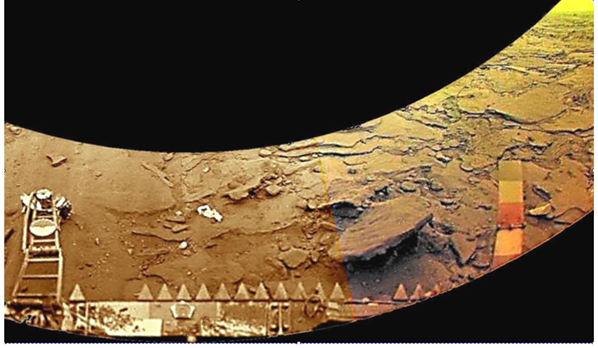
Figure 1 Planet's surface at the landing sites of VENERA-14 in modern processing. Geometric distortions are corrected.
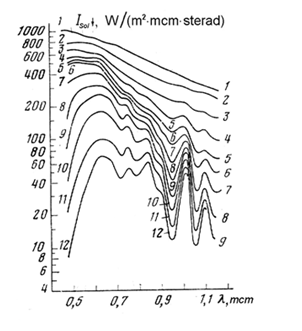
Figure 2 Scattered solar radiation spectra measured by the VENERA-14 spectrometer in the atmosphere and at the surface [3]. 1- above clouds, 2–at 62 km altitude, 3 – 55, 4 – 52, 5 – 49, 6 – 40, 7 – 25, 8 – 16.5, 9 – 10, 10 – 4.5, 11- 1, 12–0 km.

Figure 3 Image of the planet's surface based on VENERA-9 panoramas of the landing site (1975) in modern processing.

Figure 4 Intensity and spectral distribution of the solar radiation at surfaces of Earth (clean sky) and Venus.
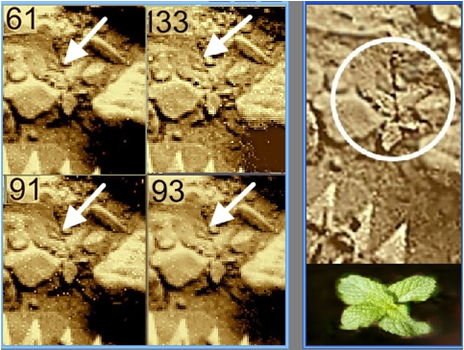
Figure 5 Left: 4 repeated fragments of the surface image at the landing site of VENERA14. A “scratch” is shown by arrows. Right: Stacked image of the first found "stem" that is a thin vertically arranged trunk that has a height of approximately 42 cm and a thickening ("burgeon") on the top. The "stem" is located at a distance of approximately 40 cm from the landing buffer of the VENERA-14 lander and is seen from above. Below are leaves of an Earth’ quatrefoil.
Stems with flowers
To search for other stems, an additional processing of the VENERA-13 and -14 panoramas has been made to improve the clarity of the details. More information about the properties of the panoramas is presented in2. "Green" panoramas are difficult to use because they are noisier. At the VENERA-13 landing site, only one or two “stems” were found, for which the base of the “stems”, similar to in Figure 5, were in a crack between the stones. This circumstance can be important because the soil here is mainly fragmented, but the stems there were not found. This interesting object is shown in Figure 6, which presents four consecutive images of a stem that was found in the VENERA-13 panoramas. The “stem” in Fig. 6 is lower than in Figure 5; it is more distant, and the stem itself is not easy to notice, although there are eight distinct images (duplicates), which allows for batch processing. The attention is drawn to the top of the stem, which appears in parts of Figure 6 as a triad of bright dots that are visible on all of the original high-contrast images. The position of the triad is not identical in successive frames. It varies slightly with respect to the adjacent light-colored stone on top of it. Changes arise from the swinging of the triad by the wind as seen by animation (Figure 7). The wind speed is low, about 0.4 m/s but the gas density is high. A clearer picture of the stem is highlighted by the circle in Figure 8. The top of the “stem” is more complex than the triad (or bud in Figure 5). The object is visible from above, and its height, which is found by its position on the photoplan, is only approximately 20cm at the base in the crack between the stones. At its base, there is a group of four bright details, similar to the "quatrefoil" leaves shown in Figure 5; that appears to be associated with the stem, too. It has been suggested that the complex structure of the top of the stem is an opened burgeon. When processing the image with a decreasing contrast, this assumption was confirmed and allowed us to see the whole "flower" of a regular shape (Figure 8), with a white spot (pestle?) in the center and the surrounding petals. The flower is composed of six to eight light petals. Its right-hand bright part forms the triad that is repeated on all of the duplicates in Figure 6, as part of an open flower. The flower size is approximately the same as a "quatrefoil" at the base of the stem. The VENERA-13 panorama has been organized in such a way that Fig. 6 represents only a fragment of the black-and-white image; thus, one can talk about only the bright colors of the petals, and their color in Figure 8 is unknown.
Another interesting but unobtrusive very small bright quatrefoil was detected at the center of the VENERA-14 panoramas (Figure 9, see frames 1 and 2) in a depression that is near to the landing buffer, opposite side to the Fig. 5. In contrast to Fig. 5, its "leaves" are very bright (young?), only slightly darker than the white cap released from the TV camera (Figure 1). One of the quatrefoil elements is in the shadow of a stone. The dimensions of the "leaves" are not more than 2cm. Despite its smaller size, the object similarity with Figure 5 is obvious. The “stem” itself is difficult to see on the source panoramas (frame 1); it was isolated by using a gamma-correction (shown in column 3 as consecutive original pictures, Figure 9, frame 3) and is seen in column 4 in final version. The height of the plant observed from above is approximately 10cm. There is a "flower" seen on its top, also. When the image is processed, the “stem” gets viewed as in Figure 9, frame 4. The dimensions of the "flower" are approximately 2cm, too. To the right of it, another "flower" is visible, the stem of which apparently is placed behind the stone. In Figure 9, “stem” and "flower" are seen against the background of contrasting details and cracks in the stone slab recess. The stem rises from the recess. The object is relatively close to the camera (less than 1 m), but the “flower” is small, and compared with Figure 6, the resolution is low.
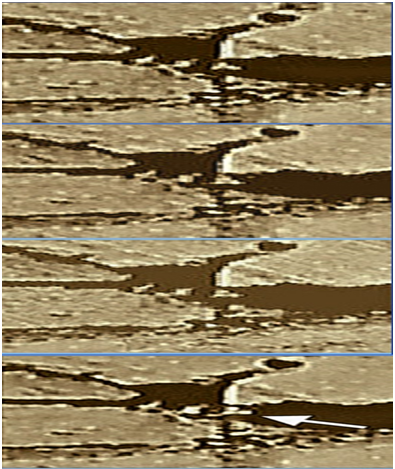
Figure 6 4 consecutive images of the landing site of VENERA-13 obtained within 1 hour. Arrow in the foreground points ”stem with a flower”.
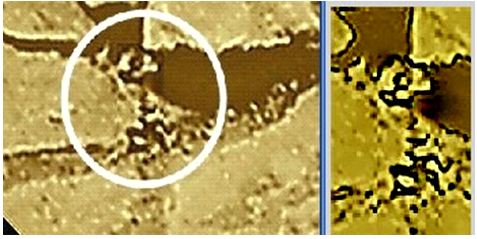
Figure 8 Flower - the same object as in Fig. 6, with gradually lowered contrast. The detailed image of the "flower" shows its light central part and leaves at the base. The diameter of the flower and the "quatrefoil" at the base are 5-8cm.
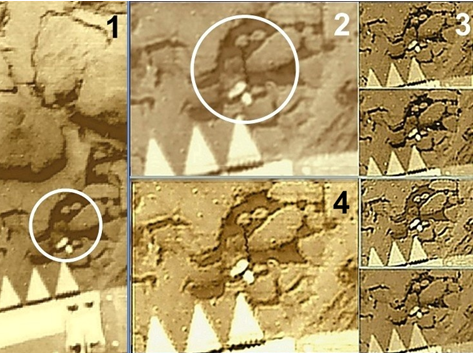
Figure 9 Stem (1, 2) with a bright "quatrefoil" located directly at the landing buffer of VENERA-14; its recurring images are shown on four consecutive panoramas (column 3). The processed image is shown in frame (4). To the right of the "flower", there is another "flower" visible, the stem of which is situated behind the stone.
On the possible role of burgeons and flowers
The landing site around the landers VENERA-13 and VENERA-14 showed vertically oriented objects that were similar to the stems of terrestrial plants. Probably, the ‘stems’ are widespread on the planet, because they are met at landing distances between the three different VENERA missions that were 900 and 4500 km. The both VENERA-14 cameras registered stems at opposite sides of the lander. The VENERA-9 and VENERA-13 cameras registered stem at one side only. The stems are important objects of a hypothetical Venusian flora discussed in.2,15–17 If the tops of the stems really are the burgeons and flowers, one should reflect their role. The flowers of terrestrial plants are intended for their pollination and reproduction. Pollination is conducted either by insects or by the wind. Wind-pollinated plants do not require blooms in principle, for example, the case of the poplar "fluff." Flowers attract insects. Do the tops of the stems in Fig. 5, 8 and 9, at least indirectly, hint on the likely participants in the process of pollination? Terramorphism of hypothetical objects of the flora and fauna of Venus was observed repeatedly in many entities.2,14,15,17 for example, a terramorphic is object "mushroom". Flowers with their petals in Figures 6 and 8 are new objects that are surprising to find, and it is surprising to find the occurrence of the same forms of living objects on different planets that have different physical conditions. However, what are the laws of nature that determine the recurrence of terramorphic hidden in such markedly different environments? The high-density hypothetical habitability of Venus2,4,18 suggests that its surface is more similar to the bottom of a sea shoal on Earth than on the Earth's surface. If the autotrophic flora is a possible source of energy that could be used by the hypothetical fauna of the planet, then the detection of "stems" would be corroborated. However, this autotrophic nature itself does not solve the problem of feeding to the fauna these rare plants.
Smaller vegetation, such as grass or moss, is not resolvable in the VENERA pictures. Some indirect evidence of the fact that the stems and mushrooms do not exhaust the variety of small-scale flora of the planet is given in.17 The author suggests a name "amisada” for these objects of fauna of Venus, which are found in the VENERA-14 panoramas. Consecutive images of one of the "amisada" show that its positions are not identical. With the help of animation, it was found that amisada most likely make swinging movements. This motion could be a process for the purpose of searching for foods that have a much smaller dimension than the stems. The Earth's flora once began the evolution in carbon dioxide oxygen-free atmosphere, for which the composition was similar to the current atmosphere of Venus. As noted, the illumination on the surface of the planet Venus energetically complies with Earth photosynthesis. Therefore, apart from the very large difference in the physical conditions, the flora of Venus should not be less rich than the Earth’s flora.
In 1982 experiments in television photography instrumented by the landers VENERA-13 and VENERA-14, returned panoramas of the Venus surface at their landing sites. Analysis of treated anew VENERA-13 and -14 panoramic images revealed 'stem' objects possessing apparent terramorphic features of Earth-like plants. ‘Stems’ are thin vertical trunks that have a thickness of 0.3-3cm and are 0.1 to 0.5m in height. On close objects, one can see that the ‘stem’ at the top end is provided with a large bulge, a "burgeon" or “flower” that is 2-8cm in diameter, with petals surrounding a bright center. At the base of the stems, there are features that resemble leaves in a quatrefoil. The terramorphic features of the hypothetical flora of Venus, if they are confirmed, may point out at outstandingly important and yet undiscovered general laws of the animated nature.
The authors declared there is no conflicts of interest.

©2019 Ksanfomality, et al. This is an open access article distributed under the terms of the, which permits unrestricted use, distribution, and build upon your work non-commercially.